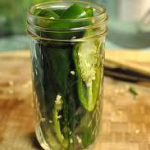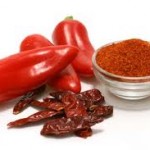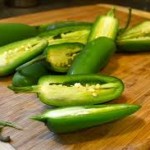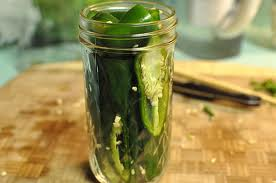Capsaicin (/kæpˈseɪ.ɨsɪn/; 8-methyl-N-vanillyl-6-nonenamide, (CH3)2CHCH=CH(CH2)4CONHCH2C6H3-4-(OH)-3-(OCH3) ) is the active component of chili peppers, which are plants belonging to the genus Capsicum. It is an irritant for mammals, including humans, and produces a sensation of burning in any tissue with which it comes into contact. Capsaicin and several related compounds are called capsaicinoids and are produced as a secondary metabolite by chili peppers, probably as deterrents against certain herbivores and fungi. Pure capsaicin is a hydrophobic, colorless, odorless, crystalline to waxy compound.
History
 The compound was first extracted (albeit in impure form) in 1816 by Christian Friedrich Bucholz (1770–1818). He called it “capsicin,” after the genus Capsicum from which it was extracted. John Clough Thresh (1850–1932), who had isolated capsaicin in almost pure form, gave it the name “capsaicin” in 1876. But it was Karl Micko who first isolated capsaicin in pure form in 1898. Capsaicin’s empirical formula (chemical composition) was first determined by E. K. Nelson in 1919; he also partially elucidated capsaicin’s chemical structure. Capsaicin was first synthesized in 1930 by E. Spath and S. F. Darling. In 1961, similar substances were isolated from chili peppers by the Japanese chemists S. Kosuge and Y. Inagaki, who named them capsaicinoids.
The compound was first extracted (albeit in impure form) in 1816 by Christian Friedrich Bucholz (1770–1818). He called it “capsicin,” after the genus Capsicum from which it was extracted. John Clough Thresh (1850–1932), who had isolated capsaicin in almost pure form, gave it the name “capsaicin” in 1876. But it was Karl Micko who first isolated capsaicin in pure form in 1898. Capsaicin’s empirical formula (chemical composition) was first determined by E. K. Nelson in 1919; he also partially elucidated capsaicin’s chemical structure. Capsaicin was first synthesized in 1930 by E. Spath and S. F. Darling. In 1961, similar substances were isolated from chili peppers by the Japanese chemists S. Kosuge and Y. Inagaki, who named them capsaicinoids.
In 1873 German pharmacologist Rudolf Buchheim (1820–1879) and in 1878 the Hungarian doctor Endre HÅ‘gyes stated that “capsicol” (partially purified capsaicin) caused the burning feeling when in contact with mucous membranes and increased secretion of gastric juice.
Capsaicinoids
Capsaicin is the main capsaicinoid in chili peppers, followed by dihydrocapsaicin. These two compounds are also about twice as potent to the taste and nerves as the minor capsaicinoids nordihydrocapsaicin, homodihydrocapsaicin, and homocapsaicin. Dilute solutions of pure capsaicinoids produced different types of pungency; however, these differences were not noted using more concentrated solutions.
Capsaicin is believed to be synthesized in the interlocular septum of chili peppers by addition of a branched-chain fatty acid to vanillylamine; specifically, capsaicin is made from vanillylamine and 8-methyl-6-nonenoyl CoA (where CoA = Coenzyme A). Biosynthesis depends on the gene AT3, which resides at the pun1 locus, and which encodes a putative acyltransferase.
 Besides the six natural capsaicinoids, one synthetic member of the capsaicinoid family exists. Vanillylamide of n-nonanoic acid (VNA, also PAVA) is used as a reference substance for determining the relative pungency of capsaicinoids.
Besides the six natural capsaicinoids, one synthetic member of the capsaicinoid family exists. Vanillylamide of n-nonanoic acid (VNA, also PAVA) is used as a reference substance for determining the relative pungency of capsaicinoids.
|
Capsaicinoid  name |
Abbrev. |
Typical |
Scoville |
| Capsaicin | C | 69% | 16,000,000 |
| Dihydrocapsaicin | DHC | 22% | 16,000,000 |
| Nordihydrocapsaicin | NDHC | 7% | 9,100,000 |
| Homodihydrocapsaicin | HDHC | 1% | 8,600,000 |
| Homocapsaicin | HC | 1% | 8,600,000 |
| Nonivamide | PAVA | 9,200,000 |
Natural function
Capsaicin is present in large quantities in the placental tissue (which holds the seeds), the internal membranes and, to a lesser extent, the other fleshy parts of the fruits of plants in the genus Capsicum. The seeds themselves do not produce any capsaicin, although the highest concentration of capsaicin can be found in the white pith of the inner wall, where the seeds are attached.
The seeds of Capsicum plants are predominantly dispersed by birds. The TRPV1 channel to which capsaicin binds does not respond to capsaicin and related chemicals in birds (avian vs mammalian TRPV1 show functional diversity and selective sensitivity). Chili pepper seeds consumed by birds pass through the digestive tract and can germinate later, but mammals have molar teeth, which destroy seeds and prevent them from germinating. Thus, natural selection may have led to increasing capsaicin production because it makes the plant less likely to be eaten by animals that do not help it reproduce. There is also evidence that capsaicin evolved as an anti-fungal agent.
In 2006, it was discovered that tarantula venom activates the same pathway of pain as is activated by capsaicin, the first demonstrated case of such a shared pathway in both plant and animal anti-mammal defense.
Uses
Food
 Because of the burning sensation caused by capsaicin when it comes in contact with mucous membranes, it is commonly used in food products to give them added spice or “heat” (piquancy). In high concentrations, capsaicin will also cause a burning effect on other sensitive areas of skin. The degree of heat found within a food is often measured on the Scoville scale. In some cases people enjoy the heat; there has long been a demand for capsaicin spiced food and beverages. There are many cuisines and food products featuring capsaicin such as hot sauce, salsa, and beverages.
Because of the burning sensation caused by capsaicin when it comes in contact with mucous membranes, it is commonly used in food products to give them added spice or “heat” (piquancy). In high concentrations, capsaicin will also cause a burning effect on other sensitive areas of skin. The degree of heat found within a food is often measured on the Scoville scale. In some cases people enjoy the heat; there has long been a demand for capsaicin spiced food and beverages. There are many cuisines and food products featuring capsaicin such as hot sauce, salsa, and beverages.
Beverage
Recently beverage products are emerging with capsaicin as an active ingredient. The first two capsaicin beverages to hit the market are Prometheus Springs Elixirs launched in 2007 and Sweet16 launched in 2011. It is common for people to experience pleasurable and even euphoriant effects from ingesting capsaicin. Folklore among self-described “chiliheads” attributes this to pain-stimulated release of endorphins, a different mechanism from the local receptor overload that makes capsaicin effective as a topical analgesic. In support of this theory, there is some evidence that the effect can be blocked by naloxone and other compounds that compete for receptor sites with endorphins and opiates.
